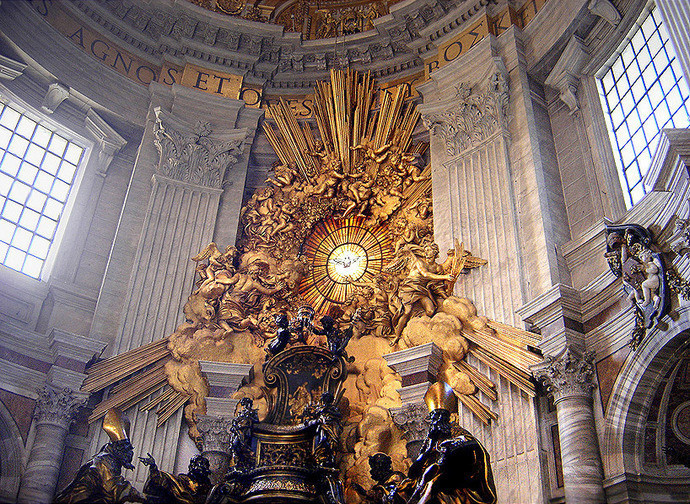Chair of Saint Peter
"'Who do you say I am?' Simon Peter replied: 'You are the Christ, the Son of the living God'". Jesus' question to the disciples and the answer of his vicar on earth recall the reason for the liturgical feast of the Chair of Saint Peter, which is based precisely on the mission of shepherd of the universal Church entrusted by Our Lord to the Prince of the Apostles.

"'Who do you say I am?' Simon Peter replied: 'You are the Christ, the Son of the living God'". Jesus' question to the disciples and the answer of his vicar on earth recall the reason for the liturgical feast of the Chair of Saint Peter, which is based precisely on the mission of shepherd of the universal Church entrusted by Our Lord to the Prince of the Apostles: "Simon son of Jonah, you are a blessed man! For it was not blood and flesh that revealed this to you but my Father in Heaven. So I now say to you: You are Peter, and on this rock I will build my church. And the gates of the netherworld shall not prevail against it. I will give you the keys of the kingdom of Heaven: whatever you bind on earth will be bound in heaven; whatever you loose on earth will be loosed in heaven." (cf. Mt 16: 13-19).
The authority conferred by Christ to Peter, an immense grace involving great responsibility, is already evident in the new name, divinely chosen and communicated in the touching scene described by Saint John the Evangelist. In fact, at the first meeting with the Prince of the Apostles, Jesus fixed His gaze on him and said: "You are Simon, the son of John: you will be called Cephas (which means Peter)", announcing that he would be the foundation of his Church (Jn 1:42). Peter, indicated as the first of the Twelve in the lists of all four Gospels and in the Acts of the Apostles, is the one who receives from Jesus the supreme office to confirm his own brothers in the faith (Lk 22: 31-32) and to feed Christ's sheep (Jn 21: 15-19), in order to guarantee unity in truth and avoid confusion in the Church, His holy fold. As Saint Leo the Great said: "Among the people of God there are many priests and shepherds, but the true guide of all is Peter, under the supreme escort of Christ". This means that Peter, like all his successors, is the Servus servorum Dei, the "Servant of the servants of God" (as defined by Saint Gregory the Great), called to guide the Church in humility and faithfulness to Holy Scripture and Holy Tradition.
The feast of the Chair of Saint Peter has very ancient origins, with documentation that goes back to the 3rd century. From the Latin cathedra, "chair" indicates the seat of the bishop (for this reason, the Mother Church of a diocese is called "cathedral"), including the Holy Father's, as Bishop of Rome; in fact, Rome is the city where Peter suffered martyrdom, bearing his greatest witness to Christ. Regarding the term cathedra as referred to the Petrine authority, it is found as early as in the writings of Tertullian (ca. 155-230) and of Saint Cyprian (210-258), Bishop of Carthage and martyr. The latter wrote: "God is one and Christ is one, and the Church is one, as one is the chair founded on Peter by the voice of the Lord".
The Depositio martyrum, an ancient calendar in use in the Church of Rome, dating back to 336, already indicated February 22nd as the only date of the feast by the title of Natale Petri de cathedra. Subsequently, the feast was split between two dates: January 18th for Rome's episcopal see, treated as the main celebration, and February 22nd for the Antioch see, whose church was founded by Peter himself. With the revision of the General Roman Calendar made under John XXIII in 1960, the two feasts were reunited on February 22nd.
The relic still preserved in Saint Peter's Basilica, and venerated precisely as the Chair of Saint Peter, has a complex history. Here we can briefly remember that the seat on which the first pope sat is kept inside the splendid Baroque structure created by Gian Lorenzo Bernini during the pontificate of Alexander VII (1655-1667), with four Doctors of the Church (Saint Augustine, Saint Ambrose, Saint Athanasius and Saint John Chrysostom) in the act of supporting the actual chair, and surmounted by a stained-glass window with the picture of a dove, symbol of the Holy Spirit. According to an analysis carried out in the 19th century by Giovanni Battista de Rossi and Raffaele Garrucci, two well-known archaeologists, the oldest part of the relic is in simple oak wood, cut in several places and at different times (presumably by devotees), and strengthened with pieces of acacia wood, probably in the 9th century.




